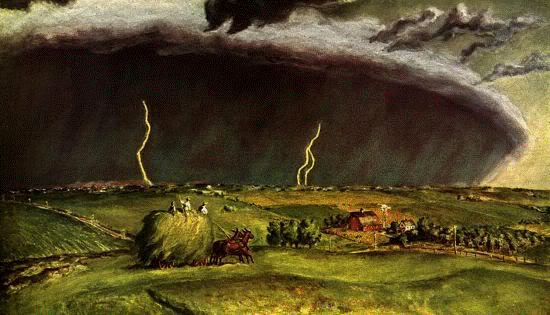As most readers of this blog are aware, I’ve argued repeatedly that colloquy is better than soliloquy…I look forward to guest posts, and have been thankful for the few I’ve received…from John Plodinec and Akiva Fishman in particular. A diversity of views forming a rich conversation has far more to offer than one person’s ruminations.
Today we’re publishing another guest post, this from George Leopold… a long-time Washington-based science and technology writer who is now working with the Policy Program here at the American Meteorological Society. George has spent many years tracking developments in science and technology generally and space technology in particular. You’ll enjoy his perspective on weather satellites and the impending sequestration, presented here verbatim. I hope we’ll be hearing much more from George (and from the rest of you as well!) with time.
__________________________________
Weather observation, forecasting and services are kind of like power: You can’t do much without them.
Speaking of power, it was lost for many days around Washington, DC, after last June’s derecho. (The term “derecho” is derived from the Spanish word for “straight,” or “direct.” In meteorological terms, it’s a thunderstorm-induced, straight-line windstorm that covers at lot of ground.)
“The Line Storm,” by John Steuart Curry
The key thing about the derecho, something I had never experienced, is that my wife and I knew something big was coming, and it was moving incredibly fast. I recall checking weather.com before putting on a Netflix movie at about 8 p.m. on that steaming Friday evening. I saw a huge storm over the Midwest, and told my wife it was going to rain on Saturday. I also recall seeing “107 F” that afternoon on the digital thermometer.
There was a helluva lot of energy in the air that day.
When the movie ended, I checked the radar again. Incredibly, the storm I had seen over Indiana two hours earlier was now approaching Northern Virginia. I went outside to secure the deck furniture. I could hear tree branches snapping as the derecho came over the old Reston Ridge Road.
Those without power and air conditioning suffered for days while utility crews repaired the power lines taken down by many downed trees.
Seven months after the storm, our lawmakers dither and finger point as a budgetary meat ax threatens to create a gap in the coverage provided by weather and Earth observation satellites. Those satellite images and weather predictions we grab with a swipe of our iPads could become much harder to come by if a new generation of NOAA weather satellites are delayed in the name of deficit reduction (a worthy cause that tends to involved cutting someone else’s budget).
The consequences of a projected 17-month gap in satellite coverage are addressed here (http://www.spaceinourworld.com). The short version is that the expected design life of the current Suomi polar-orbiting weather satellite is 2016, but the first of a series of Joint Polar Satellites System (JPSS-1) won’t launched until 2018.
Other scenarios described in a U.S. Government Accounting Office risk report contemplate gaps in satellite coverage as long as 53 months.
In a perfect storm of tight budgets, political stasis and increasingly frequent extreme weather across the United States, we face the prospect of flying with one eye closed when it comes to weather forecasting and storm warnings.
The promise of innovations like “now casting” are beginning to look more like “then casting.”
As for budget forecasts, the folks who build weather satellites said in the days before budget sequestration was schedule to hit that they have little visibility into what will happen at NOAA and NASA. Much depends on how those agencies implement across-the-board cuts in discretionary spending mandated in the budgetary version of a derecho.
One possible scenario is that current work on JPSS-1 will continue, but funds for future work on JPSS-2 would be cut. That might be wishful thinking by a government contractor hoping to keep production lines open. The bottom line is that any budget cuts will delay the launch of new weather satellites and that will create gaps in satellite coverage at a time when we are struggling to understand the science behind our extreme weather.
In human terms, the number of lives lost in tornados, derechos, hurricanes and blizzards like the Feb. 13 “A Bomb” that buried New England is directly proportional to the quality of weather warnings and how fast they are broadcast.
As the saying goes, “Everyone talks about the weather, but nobody does anything about it.” We have in our hands the technologies and science to do something about our extreme weather. Given budget cuts and competing demands for scarce dollars, it would be foolish not to include weather and Earth observation satellites on our list of priorities.
– George Leopold


The Europeans are facing similar budgetary problems:
http://www.nature.com/news/esa-s-climate-eye-dilemma-1.12539?WT.ec_id=NATURE-20130307
http://www.washingtonpost.com/politics/federal_government/sequester-could-ultimately-affect-severe-weather-forecasting/2013/03/05/b41555ee-850b-11e2-9d71-f0feafdd1394_story.html
<a href"http://www.washingtonpost.com/politics/federal_government/sequester-could-ultimately-affect-severe-weather-forecasting/2013/03/05/b41555ee-850b-11e2-9d71-f0feafdd1394_story.html"The Washington Post reports that Rep. Frank Wolf (R-Va.) is willing to consider of “reprogramming [of funds] on an expedited basis” to shore up National Weather Service forecasting.
Some good news from the House, which approved funding for NOAA’s GOES-R satellite acquisition. According to reports, the House budget allocates $802 million in FY 2013. After factoring for sequestration (not inflation!), that reportedly works out to $762 million — not enough, but better than a budget cut. Action now shifts to the Senate, where Barbara Mikulski (D-Md.) apparently has her own ideas about how to fund government agencies like NOAA.
Here are details:
http://www.climatecentral.org/news/house-votes-to-increase-weather-satellite-funding-15694